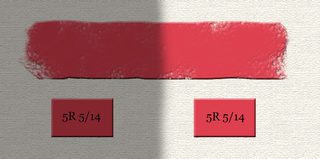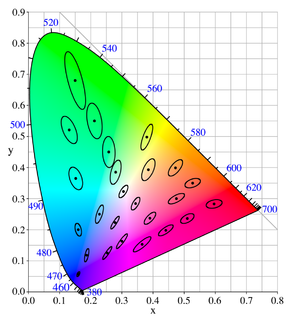
The color temperature of a light source is the temperature of an ideal black-body radiator that radiates light of a color comparable to that of the light source. Color temperature is a characteristic of visible light that has important applications in lighting, photography, videography, publishing, manufacturing, astrophysics, horticulture, and other fields. In practice, color temperature is meaningful only for light sources that do in fact correspond somewhat closely to the radiation of some black body, i.e., light in a range going from red to orange to yellow to white to blueish white; it does not make sense to speak of the color temperature of, e.g., a green or a purple light. Color temperature is conventionally expressed in kelvins, using the symbol K, a unit of measure for absolute temperature.

In color theory, hue is one of the main properties of a color, defined technically in the CIECAM02 model as "the degree to which a stimulus can be described as similar to or different from stimuli that are described as red, orange, yellow, green, blue, violet," which in certain theories of color vision are called unique hues.

The CIELAB color space also referred to as L*a*b* is a color space defined by the International Commission on Illumination in 1976. It expresses color as three values: L* for perceptual lightness, and a* and b* for the four unique colors of human vision: red, green, blue, and yellow. CIELAB was intended as a perceptually uniform space, where a given numerical change corresponds to similar perceived change in color. While the LAB space is not truly perceptually uniform, it nevertheless is useful in industry for detecting small differences in color.
Chromatic adaptation is the human visual system’s ability to adjust to changes in illumination in order to preserve the appearance of object colors. It is responsible for the stable appearance of object colors despite the wide variation of light which might be reflected from an object and observed by our eyes. A chromatic adaptation transform (CAT) function emulates this important aspect of color perception in color appearance models.

Colorfulness, chroma and saturation are attributes of perceived color relating to chromatic intensity. As defined formally by the International Commission on Illumination (CIE) they respectively describe three different aspects of chromatic intensity, but the terms are often used loosely and interchangeably in contexts where these aspects are not clearly distinguished. The precise meanings of the terms vary by what other functions they are dependent on.

A color rendering index (CRI) is a quantitative measure of the ability of a light source to reveal the colors of various objects faithfully in comparison with an ideal or natural light source. Light sources with a high CRI are desirable in color-critical applications such as neonatal care and art restoration. It is defined by the International Commission on Illumination (CIE) as follows:
Color rendering: Effect of an illuminant on the color appearance of objects by conscious or subconscious comparison with their color appearance under a reference illuminant.
A color model is an abstract mathematical model describing the way colors can be represented as tuples of numbers, typically as three or four values or color components. When this model is associated with a precise description of how the components are to be interpreted, the resulting set of colors is called "color space." This section describes ways in which human color vision can be modeled.

In the study of color vision, a MacAdam ellipse is a region on a chromaticity diagram which contains all colors which are indistinguishable, to the average human eye, from the color at the center of the ellipse. The contour of the ellipse therefore represents the just-noticeable differences of chromaticity. Standard Deviation Color Matching in LED lighting uses deviations relative to MacAdam ellipses to describe color precision of a light source.

CIE standard illuminant D65 (sometimes written D65) is a commonly used standard illuminant defined by the International Commission on Illumination (CIE). It is part of the D series of illuminants that try to portray standard illumination conditions at open-air in different parts of the world.
Relative luminance follows the photometric definition of luminance including spectral weighting for human vision, but while luminance is a measure of light in units such as , Relative luminance values are normalized as 0.0 to 1.0, with 1.0 being a theoretical perfect reflector of 100% reference white. Like the photometric definition, it is related to the luminous flux density in a particular direction, which is radiant flux density weighted by the luminous efficiency function y(λ) of the CIE Standard Observer.

A standard illuminant is a theoretical source of visible light with a spectral power distribution that is published. Standard illuminants provide a basis for comparing images or colors recorded under different lighting.
Adams chromatic valence color spaces are a class of color spaces suggested by Elliot Quincy Adams. Two important Adams chromatic valence spaces are CIELUV and Hunter Lab.

Lightness is a visual perception of the luminance of an object. It is often judged relative to a similarly lit object. In colorimetry and color appearance models, lightness is a prediction of how an illuminated color will appear to a standard observer. While luminance is a linear measurement of light, lightness is a linear prediction of the human perception of that light.
In colorimetry, the CIE 1976L*, u*, v*color space, commonly known by its abbreviation CIELUV, is a color space adopted by the International Commission on Illumination (CIE) in 1976, as a simple-to-compute transformation of the 1931 CIE XYZ color space, but which attempted perceptual uniformity. It is extensively used for applications such as computer graphics which deal with colored lights. Although additive mixtures of different colored lights will fall on a line in CIELUV's uniform chromaticity diagram, such additive mixtures will not, contrary to popular belief, fall along a line in the CIELUV color space unless the mixtures are constant in lightness.
The difference or distance between two colors is a metric of interest in color science. It allows quantified examination of a notion that formerly could only be described with adjectives. Quantification of these properties is of great importance to those whose work is color-critical. Common definitions make use of the Euclidean distance in a device independent color space.

The CIE 1960 color space is another name for the (u, v) chromaticity space devised by David MacAdam.
In colorimetry the OSA-UCS is a color space first published in 1947 and developed by the Optical Society of America’s Committee on Uniform Color Scales. Previously created color order systems, such as the Munsell color system, failed to represent perceptual uniformity in all directions. The committee decided that, in order to accurately represent uniform color differences in each direction, a new shape of three dimensional Cartesian geometry would need to be used.

Deane Brewster Judd was an American physicist who made important contributions to the fields of colorimetry, color discrimination, color order, and color vision.

Günter Wyszecki was a German-Canadian physicist who made important contributions to the fields of colorimetry, color discrimination, color order, and color vision.













